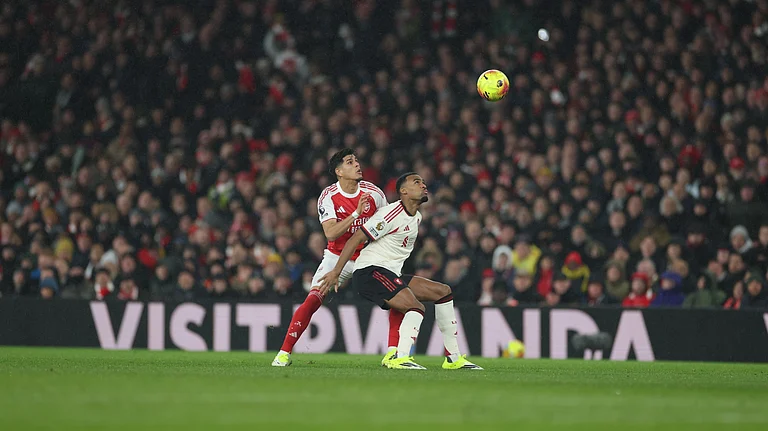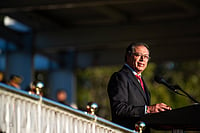The videography survey of the Gyanvapi Mosque in Varanasi, Uttar Pradesh, has led to a legal row with some questioning the constitutional validity of the move. The provisions of the 1991 Places of Worship Act have come into limelight after a civil court in Varanasi ordered the videographic survey of the Gyanvapi mosque complex located next to the Kashi Vishwanath temple in response to a petition by certain Hindu groups who claim the mosque was built by Aurangazeb after demolishing Hindu temples. After the survey on Monday, the counsel representing the Hindu side claimed that a Shivling was found close to the "wazookhana"-- a small reservoir used by Muslim devotees to perform ritual ablutions before offering the namaz.
The claims have been contested by the members of the Anjuman Intezamiya Masjid Committee who have raised the matter in the Supreme Court and claimed the survey contravened the Places of Worship Act. While authorities undertaking the survey are yet to file the final report on the findings of the survey,many including mosque management committee members, members of the Muslim intelligentsia, political parties and civil society have objected to any proposed attempt to alter the religious character of the Gyanvapi Mosque.
What is the Places of Worship Act?
The Places of Worship Act was passed by the Parliament in 1991 and aims to maintain the status quo between religions. It was introduced at a time when the veteran BJP leader LK Advani's Rath Yatra and Ram Janmabhoomi movement was gaining momentum and leading to incidences of violence in Uttar Pradesh. The Act was the result of a Bill passed by Shankarrao Bhavrao Chavan, former union home minister in the PV Narasimha Rao Cabinet.
The Bill came in the backdrop of the shooting of kar sevaks in Uttar Pradesh and the arrest of LK Advani in Bihar. As per the Bill, places of worship cannot. be converted to other religions and denominations, and the status quo on August 15, 1947 to be maintained.
What does the Act say about conversion of the religious character of places of worship?
Section 3 of the Places of Worship Act explicitly bars the conversion, in full or part, of a place of worship of any religious denomination into a place of worship of a different religious denomination. The section also bars conversions even within different sects of the same religious denomination.
According to Section 4(1) of the Act, the religious character of a place of worship “shall continue to be the same as it existed” on August 15, 1947. Aper Section 4(2), any pending legal proceeding or lawsuits regarding conversion of the religious character of any place of worship that was around on August 15, 1947,in any court, shall abate. according to the law, no fresh legal proceedings or lawsuits of such manner shall be instituted.
Exemptions under the Act
The Act exempts any "ancient and historical monument or an archaeological site or remains covered by the Ancient Monuments and Archaeological Sites and Remains Act, 1958 (24 of 1958) or any other law for the time being in force".
Section 5 of the Act also states that any cases pertaining to the Babri-Ram Janmabhoomi pending disputes were excluded from the Act.
Why the Places of Worship Act is relevant in Gyanvapi Mosque case
The Supreme Court had on Friday last refused to grant an interim order of status quo on the survey in the Gyanvapi mosque premises. The top court, however, agreed to consider listing the plea of a Muslim party against the survey which the Court agreed to hear on Tuesday.
A local Uttar Pradesh court on Monday ordered the sealing of a pond in the Gyanvapi Masjid complex after lawyers representing the Hindu petitioners said a Shivling was found there during the court-mandated videography survey. However, member of the mosque management committee Anjuman Intezamiya Masjid Committee disputed the claim, saying the object was part of the water fountain mechanism at the wazookhana reservoir where devotees carry out ablutions before offering namaz.
The petitioners have claimed that the survey is against the Act.
In the Babri Masjid judgment, the court maintained that as per the Places of Worship Act, all places of worship places henceforth will be treated as per the law and left in the same condition as they were in 1947. Parties like AIMPLB have objected to the claim of the mosque being a temple and state that such please should have immediately been rejected by the courts.
AIMPLB general secretary Khalid Saifullah Rahmani in a statement to the media said that in 1937, in the case of Deen Mohammad Vs State Secretary, the court had decided on the basis of oral testimony and documents that this entire compound (Gyanvapi mosque complex) belongs to the Muslim Waqf and Muslims have the right to offer namaz in it.
The court had also demarcated the areas that belonged to both mosque and the temple. At the same time, the wazookhana was accepted as the property of the mosque, Rahmani added.
The Waqf Board has approached the UP high court in this matter and the case is pending there.
Past petitions against the Places of Worship Act
There are at least two petitions against the Places of Worship Act in Supreme Court as of now. One was filed by a Lucknow-based Hindu outfit called the Vishwa Bhadra Pujari Purohit Mahasangh. Other petitioners include members of the Sanatan Vedic Religion as well as BJP leader Ashwini Upadhyay.
The petitioners have objected to the "arbitrary" cut off date of August 15, 1947 for deciding the religious nature of a place. Petitioners also claim the Act prevents judicial review and is thus unconstitutional.
What the SC said about the Places of Worship Act in the Ayodhya verdict
The five-judge bench headed by then Chief Justice of India Ranjan Gogoi had lauded the Places of Worship Act in its 2019 Ayodhya judgement as “a legislative instrument designed to protect the secular features of the Indian polity, which is one of the basic features of the Constitution”. Justices D Y Chandrachud, SA Bobde, S Abdul Nazeer and Ashok Bhushan were part of the bench.
(With inputs from PTI)


























